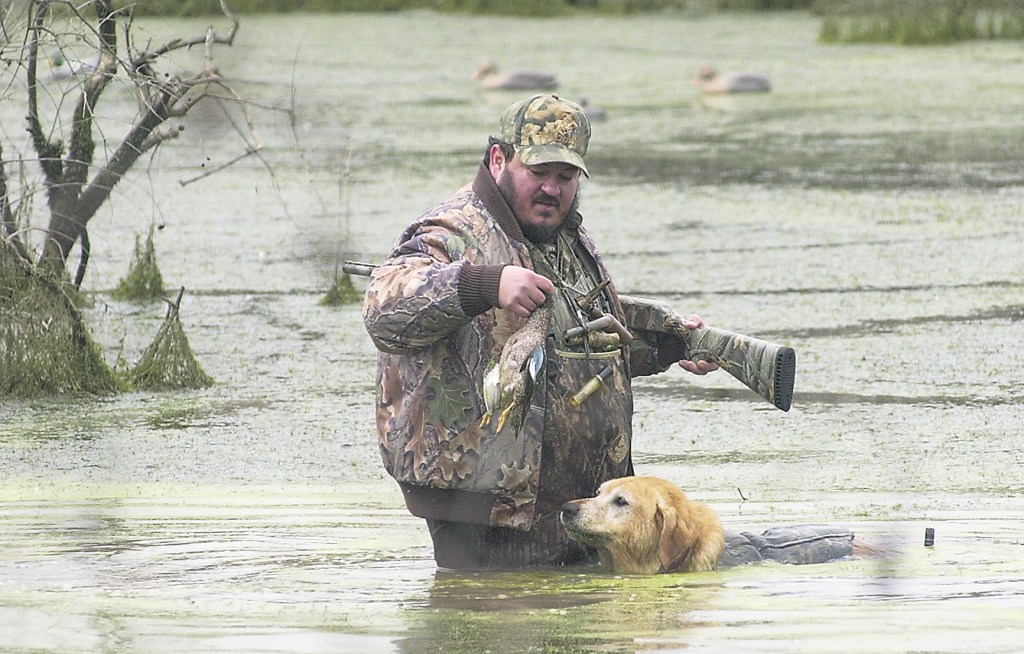More than 2 1/2 million ducks in La.
Published 8:30 am Sunday, December 29, 2019

- Duck hunters like this one are taking to the swamps, marshes, rice fields and woods for the second split. According to an aerial waterfowl population survey, there are more than 2.5 million ducks in Louisiana.
BATON ROUGE — When Larry Reynolds counted an estimated 2.57 million ducks during an aerial waterfowl population survey earlier this month, the state waterfowl study leader saw ducks grouped in huge bunches.
Clearly, Reynolds said in his report released Dec. 19, more ducks have flown into Louisiana since November. The increase from 1.04 million birds counted in last month’s survey can be attributed to the number of cold fronts that have passed through the Sportsman’s Paradise, he said.
Most of the large groups of ducks were in southeast Louisiana, where there were an estimated 894,000 dabblers and 438,000 divers for a total of 1,332,000 ducks, while the clumping was less pronounced in southwest Louisiana, where there were an estimated 935,000 dabblers and 155,000 divers for a total of 1,090,000 million ducks.
“There were a few very large concentrations with broad expanses of very few ducks. The most extreme example was in southeast Louisiana where large numbers of ring-necked ducks were counted in the fresh marsh of upper Terrebonne Parish south southeast of Amelia, then very few ducks were counted on the next four transect lines and the line just south of New Orleans for monitoring the Caernarvon freshwater diversion. Then another tremendous concentration of mostly gadwalls, pintails and ring-necked ducks was encountered from the West Bay sediment diversion on the west side of the Mississippi River north to past Venice on the east side. Those two locations accounted for about 80 percent of the estimate from the entire southeast Louisiana survey region,” Reynolds wrote in his report.
“Much less extreme, in southwest Louisiana large concentrations were seen on the East Cove unit of Cameron Prairie National Wildlife Refuge and in the marsh between Little Pecan Lake and Grand Lake. Other large concentrations of mixed species were noted off transect lines (so not included in the survey estimates) on the open water of southeast Grand Lake and both northeast and northwest portions of White Lake.”
Overall, the 2 million-plus total number ducks in this month’s survey was 32 percent higher than December 2018’s estimate of 1.95 million ducks but still 8 percent below the long-term December average of 2.81 million ducks, Reynolds said.
Estimates for all species except blue-winged teal were higher than in November. The most notable increases were for gadwall (327,000 to 944,000), ring-necked ducks (112,000 to 488,000) and mallards (3,000 to 88,000), he said.
For gadwall and ring-necked ducks, those increases were most evident in southeast Louisiana, where the total estimate jumped from 357,000 to 1.33 million from November to December, while the estimate for southwest Louisiana only increase from 597,000 to 1.09 million, he reported.
“Across the entire surveyed area, all diving duck species were above long-term December averages, as were gadwall, blue-winged teal and shovelers. Green-winged teal, however, were substantially below their long-term average (154,000 vs. 459,000) for December. It was the lowest estimate for the species since 1985 and the second-lowest ever,” he wrote.
Judging from what he saw in southwest Louisiana, duck hunters may see less ducks in the second split because habitat conditions are becoming clearer to see. Since early November, water levels in the coastal marsh in that region have declined significantly and likely are making it more difficult for dabbling ducks in many areas, he said.
There is widely variable distribution of submerged aquatics. Without favorable seed-producing annual vegetation, which was precluded by prolonged spring and summer flooding, large-scale habitat conditions are expected to be only fair, according to Reynolds.
There is an abundance of managed water in the agricultural region of the surveyed area, he wrote, but little additional shallow flooding. After strong cold fronts pushed through, broad areas, particularly in southeast Louisiana, were mostly mudflats, which likely influenced distribution of ducks, and also showed the spotty distribution of SAV, he reported.
Nevertheless, despite and suspected below-average SAV, estimates for both gadwalls and coots, species closely related to SAV, exceed long-term December averages of 906,000 and 1,210,000, respectively, the veteran waterfowl biologist wrote.





